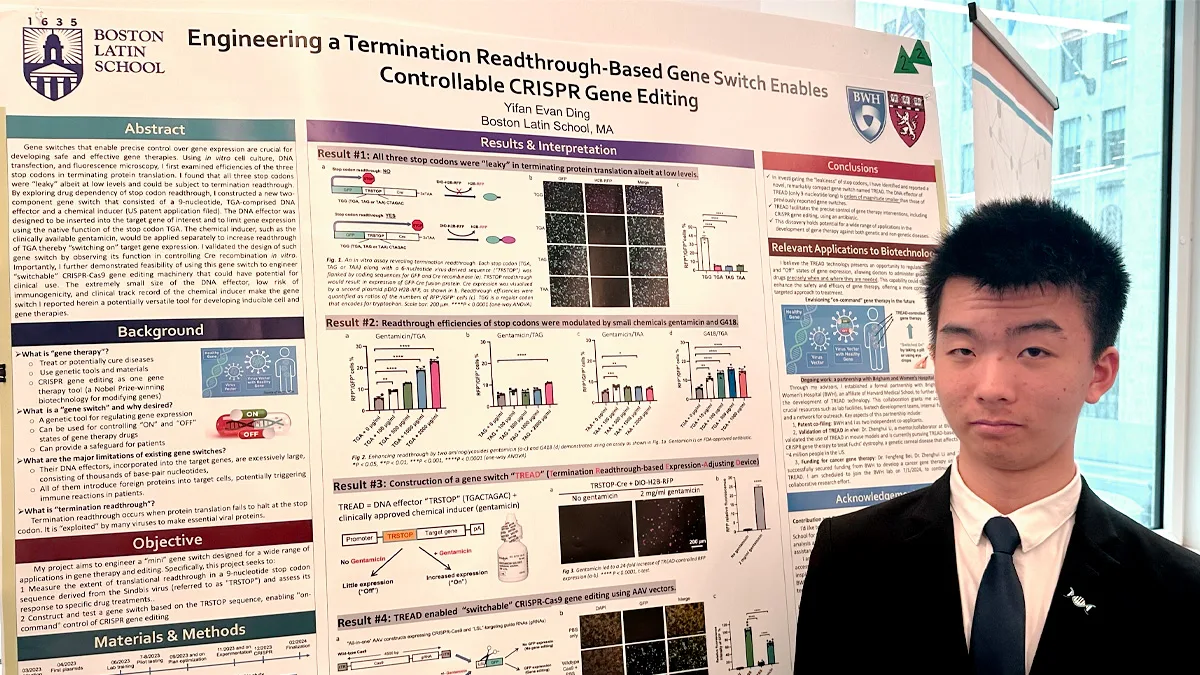
Overview
Developing and validating a novel gene switch, "TREAD," to enhancing CRISPR-based therapies earned high schooler Yifan Ding top honors in the 2024 BioGENEius Challenge.
Working on engineering gene switch to help control CRISPR gene editing
Innovative research on gene switching and its potential for treating rare diseases garnered Yifan Ding, a tenth grade student from Boston Latin School in Boston, MA, top honors as the 2024 winner of the BioGENEius Challenge.
The esteemed competition, founded by the Biotechnology Institute more than two decades ago, showcases the finest young talent in biotechnology from across the United States. Cure hosted the 2024 BioGENEius Challenge ceremonies, awarding a $2,500 prize to Ding as the overall winner, and $500 each to four finalists.
The students also toured labs at CURE and met with biopharma executives to discuss careers in the field of biotechnology. Since its inception, the BioGENEius Challenge has seen its alumni go on to impactful careers as entrepreneurs, physicians, healthcare leaders, and champions for sustainable health and environmental solutions.
Ding spoke with Cure about what inspired him, challenges he faced and the journey he took for his project, “Engineering of a compact gene switch for temporal control for CRISPR gene editing.”
This interview was edited for length and clarity.
Cure: Tell us about the inspiration behind your project? What problem were you hoping to solve?
Ding: My inspiration came from a ninth grade biology project I did about genetic diseases. I was tasked to research Rett Syndrome, a rare genetic disorder that has no current cure.
Besides Rett Syndrome, there are numerous other genetic diseases that affect millions in the United States alone. I was determined to find a way to combat such diseases using a phenomenon I read about called termination read through.
Cure: What was the biggest challenge you faced while working on your project, and how did you overcome it?
Ding: The biggest challenge was finding time to sustain and culture cells in the lab. Cells regularly need to be handled at specific intervals, and due to school, it has been really difficult for me to find time to handle them. I ended up finding help from my mentor and putting aside things I can do later to squeeze in as much time as I can.
Cure: What was the most surprising or unexpected result you encountered during your research?
Ding: The most unexpected thing to happen was how my results differed from previous results that I had read about on paper. I wasn’t sure whether or not I repeated the experiment wrong but when I followed through, to my relief, everything went fine.
Cure: How do you see the findings from your project being applied in the real world or in future scientific research?
Ding: I think my findings will be used to better the future of genetic bioengineering as it gives more power and control for doctors to administer certain gene therapy drugs for patients.
Gene therapy is known for being a “one and done” method, so finding a way to control the outcomes is a huge advancement. It is also extremely versatile, and has applications in complement to already existing groundbreaking tools like CRISPR.
Cure: What role did mentorship or collaboration play in the success of your project?
Ding: My mentor contributed everything from helping me around the lab, to handling dangerous chemicals like carcinogens, to revising my research paper. Without him, this project wouldn’t have been possible.
Cure: How has this experience influenced your academic or career goals? Do you have specific fields or industries in mind?
Ding: This gave me more confidence in my pursuit of bioengineering. The project being successful gave me more validation in continuing education in this field and to further develop my project by assessing its weaknesses.
Music has also been a big part of my life, so I plan to pursue biomedical engineering and music in the future.
Cure: What advice would you give to other students interested in participating in the BioGENEius Challenge?
Ding: Make sure that you ask an important question! Your project should address a problem that you care about in the world, and be passionate about achieving your goals!
How Ding describes his project:
Genetic mutations are a fundamental cause of diseases. There are more than 10,000 rare genetic diseases that pose a complex and significant healthcare problem. While individually rare, they collectively affect 25 to 30 million patients in the United States and over 400 million globally.
Gene therapy holds great promise for treating or even curing genetic diseases. One key challenge in gene therapy is precisely controlling the expression of therapeutic genes in the right place, at the right time, and with the right dosage. For example, "gene switch" technologies are in high demand to increase the safety and efficiency of CRISPR gene editing as a gene therapy strategy. These technologies can optimize the expression of CRISPR gene editors, ensuring they are active only when and where needed, thereby minimizing the risk of side effects.
My project aims to engineer, validate, and develop a novel gene switch termed "TREAD." Originating from my biology class, my self-funded cell culture studies in local biology labs have demonstrated proof-of-concept for the TREAD switch, revealing its potential as a versatile tool for gene therapy, including CRISPR gene editing. Ongoing efforts, supported and funded by my development partner, Brigham and Women's Hospital, aim to apply TREAD for various gene therapy applications. We are collaborating with the Rett Syndrome Research Trust in a multi-institutional effort to test TREAD for a gene-editing therapy for Rett syndrome.
I hope my research on gene switches will lead to a real contribution in treating rare genetic diseases.
Follow the BioGENEius Challenge via LinkedIn and its website: Technology Organization Serving in the US | Bio Technology Institute.








